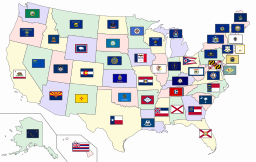By SiBr4 and respective authors of base recordsdata [CC BY-SA 3.0]
The patchwork quilt of state and native drone rules continues apace, with two extra states proposing drone legal guidelines that might severely restrict business use. The Montana Senate superior a invoice this week which might impose a civil penalty for flying a drone over non-public property under 500 toes, requiring drones to observe public roads and land. The invoice (SB 170) makes a small nod in direction of drone operators by conceding some exceptions for land surveying, insurance coverage, and regulation enforcement.
In Oklahoma, a regulation has been proposed to permit householders to shoot down drones that fly over their property. The proposal not solely threatens a harmful precedent, however contravenes federal regulation which declares that it’s illegal to shoot down plane; and the FAA clearly defines drones as plane. Oklahoma is a state that actively courts the drone business from the standpoint of commerce: by making drones a goal, legislators danger discouraging business operators for every kind of present and future purposes.
These legal guidelines, designed to guard private property rights, go a lot additional – limiting not solely the drone business however the potential profit that drones might present to these residents. Requiring drones to observe public roads eliminates among the time profit that is perhaps realized in “as the crow flies” drone supply: whereas constituents may not be involved with a time delay ready for his or her Amazon package deal, they may really feel in a different way in regards to the supply of a life-saving cardiac gadget to an accident scene, or blood plasma to a distant well being clinic. A lack of expertise about what drones can do – and how they may do it – results in rules primarily based solely on anticipated issues.
The rules have prompted remark from business leaders who concern that states will undo the regulatory progress made by the FAA. The drone business has been advocating to advertise drone security and wise regulation on a federal stage, and working quick to supply know-how instruments that higher permit drone operators to observe the foundations. With the flood of state rules, the business is struggling to handle a multi-front marketing campaign to vary public notion about drone know-how whereas maintaining with rising layers of regulation.
“The FAA and private industry have already made significant strides to assure public safety with respect to drones, including last year’s approval of the FAA’s Part 107 rule, the inclusion of sense and avoid technology in many of the latest drone models, and the adoption of tools to help drone pilots easily understand where they are and are not allowed to fly,” says Mike Winn, CEO and co-founder of DroneDeploy, an business main aerial mapping platform. “For example, pilots using DroneDeploy’s mobile app for planning flights can view notifications from airspace intelligence company, Airmap, to make sure that they do not encroach upon any airspace restrictions.”
“State-by-state drone regulations such as the ones proposed this week in Oklahoma and Montana set a bad precedent because they generate confusion among remote pilots, law enforcement and the public about what drone activities are and aren’t allowed,” says Winn. “These make it harder for operators using drones for legitimate commercial purposes to keep track of regulations and maintain compliance. By comparison, nationwide regulations from the FAA help provide regulatory clarity and allow for efficient activity by drone pilots, airmen, and law enforcement alike.”
 Unmanned Aerial Vehicle The latest drone news
Unmanned Aerial Vehicle The latest drone news




